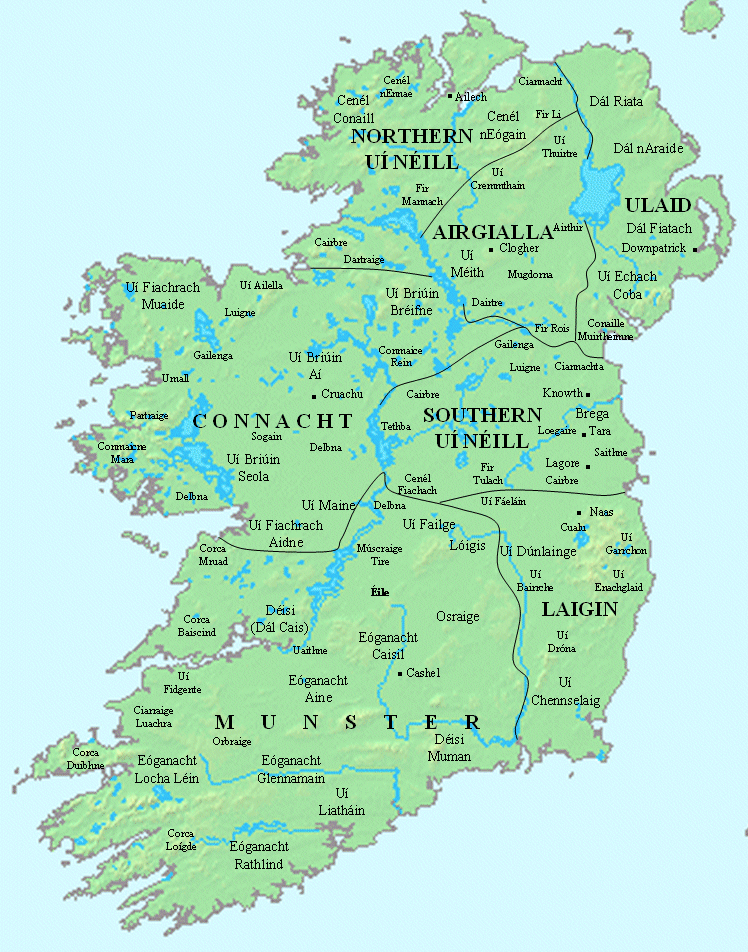 | ||
The Uí Briúin were an Irish dynasty of Connacht. Their eponymous apical ancestor was Brión, son of Eochaid Mugmedon and Mongfind, and an elder half brother of Niall of the Nine Hostages. They formed part of the Connachta, along with the Uí Fiachrach and Uí Ailello, putative descendants of Eochaid Mugmedon's sons Fiachra and Ailill. The Uí Ailello were later replaced as the third of the Three Connachta, by genealogical sleight of hand, by the Uí Maine.
Connacht was ruled in early times by the Uí Fiachrach, the Uí Briúin only becoming the dominant force in Connacht in the 7th and 8th centuries.
The Uí Briúin divided into multiple septs, the three major ones being:
The Uí Briúin kings of Connacht were drawn exclusively from these three branches.
According to Tírechán, Saint Patrick visited the "halls of the sons of Brión" at Duma Selchae (located by John O'Donovan in Mag nAí and alternatively by Roderic O'Flaherty near Loch Cime), but does not give their names. An equivalent passage in the Vita Tripartita, possibly of 9th-century origin, names six sons. "A series of later sources dating from the eleventh century onward, meanwhile, enumerates Brion's progeny as no less than twenty-four. No doubt the increasing power of the Uí Briúin was responsible for this dramatic swelling of the ranks, as tribes and dynasties newly coming under Uí Briúin sway were furnished with ancestries that would link them genealogically to their overlords. Into this category fall the Uí Briúin Umaill and likely also the Uí Briúin Ratha and Uí Briúin Sinna."
While Francis Byrne and John O'Donovan believed the dynasty originated in Mag nAí, Roderic O'Flaherty and John Colgan related traditions of Saints Patrick and Felartus visiting the sons of Brión in Maigh Seóla. A story in the Silva Gadelica notes that during the legendary war between Brión and Fiachra, Fiachra's encampment was situated in Aidhne and Brión's lay in Damh-Chluain, which is stated to be in Uí Briúin Seóla and not far from Knockma Hill, west of Tuam. Although this is of course a legend, it may be an indication of the Uí Briúin's original homeland, as is Aidhne for the Uí Fiachrach. In addition, Hubert Knox, citing the Conmaicne's distribution and early status as subjects of the Uí Briúin, posited that the Uí Briúin originated in the barony of Clare in County Galway as the leading lineage of that people. This scenario is more consistent with the fact that early Uí Briúin kings (e.g. Cenn Fáelad mac Colgan and Cellach mac Rogallaig) had their residence on Loch Cime, as well as Áed mac Echach's donation of Annaghdown in the 6th century, which Byrne thought unlikely given Annaghdown's distance from Mag nAí. With the inclusion of Máenach mac Báethíne, ancestors of all three major branches of the dynasty are mentioned in the annals as residing or fighting in the Maigh Seóla region in the 7th century. The district to the east of Lough Corrib and the River Corrib is referred to as "Magh Ua mBriuin" at least as late as 1149.
